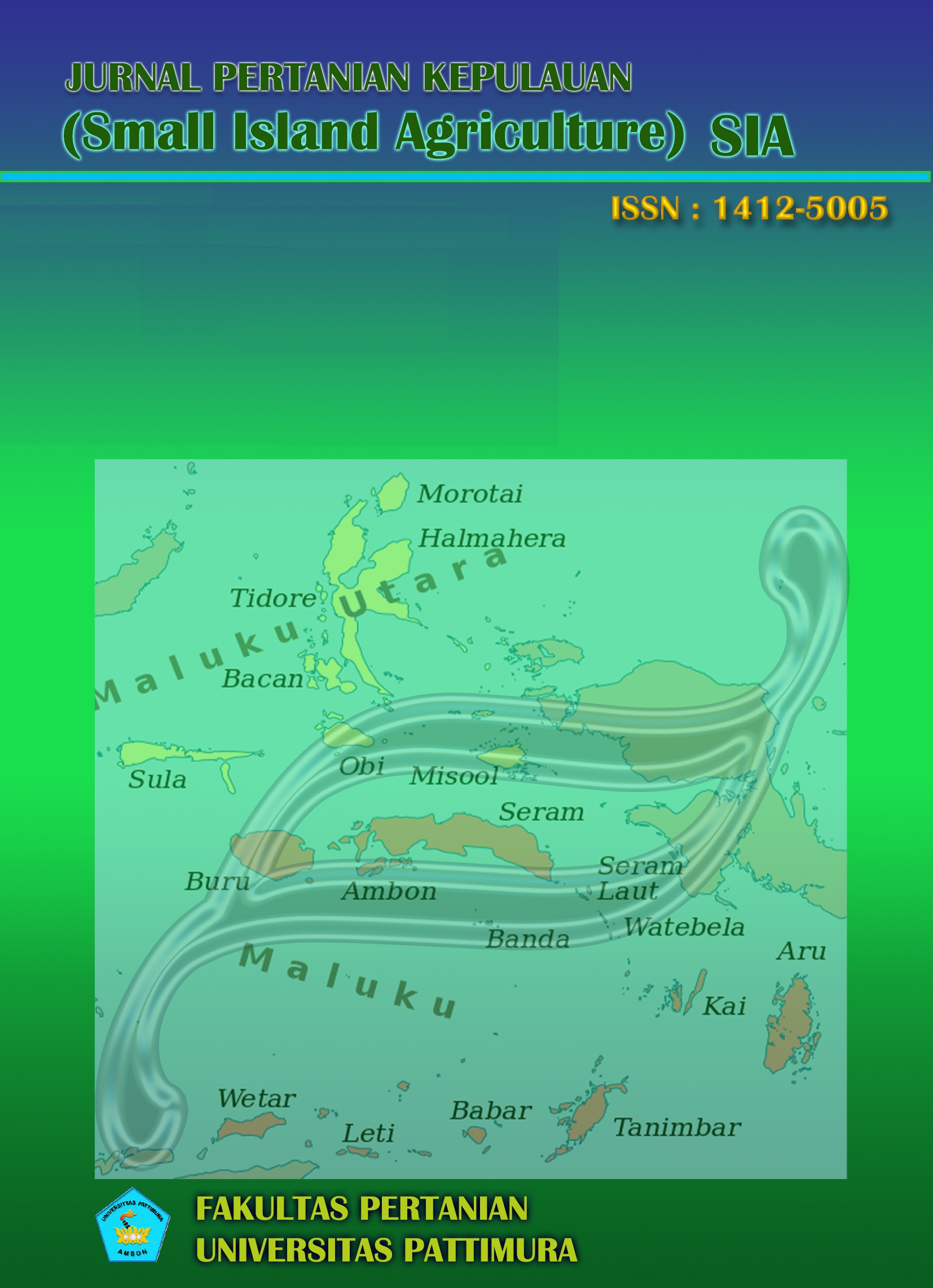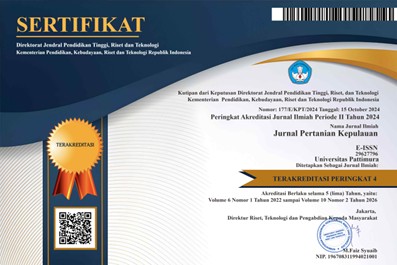Kejadian Penyakit Busuk Buah Kakao (Phytophthora palmivora var. palmivora) di Desa Karlutu, Kecamatan Seram Utara Barat, Kabupaten Maluku Tengah
Abstract
The disease of cocoa fruit rot almost infecting all cocoa planting areas in Indonesia.
The research aims to determine the disease incidence of fruit rot and its attack on
the cocoa crop in Karlutu village, North West Seram District. The research used a
completely random design block and repeated 3 times. Observations were
performed on the people's cocoa crop in the village of Karlutu and taken 10 trees as
samples for each replay. Subsequent fruit samples were carried to the laboratory and
isolated using pin-set into petri-dish containing PDA media, then incubated for 48
hours at a room temperature of 25-27 °c. The results of the study obtained the
average highest disease incidence of cocoa fruit rot disease of 54% and the lowest
(33%) in the village of Karlutu. Besides, the condition of cocoa farmer plantation
that is poorly maintained by local farmers causes the high damage caused by this
disease. Thus, required strengthening local farmer knowledge about optimal
cultivation of cocoa by implementing an effective strategy of integrated control
plant disease with an environmentally friendly approach.
Downloads
References
Adeniyi, D. (2019). Diversity Of Cacao Pathogens And Impact On Yield And Global Production. Theobroma Cacao - Deploying Science For Sustainability Of Global Cocoa Economy. Https://Doi.Org/10.5772/Intechopen.81993
Bahia, R. De C., Aguilar-Vildoso, C. I., Luz, E. D. M. N., Lopes, U. V., Machado, R. C. R., & Corrêa, R. X. (2015). Resistance To Black Pod Disease In A Segregating Cacao Tree Population. Tropical Plant Pathology, 40(1), 13–18. Https://Doi.Org/10.1007/S40858-014-0003-7
Baihaqi, A., Hamid, A., Anhar, A., Abubakar, Y., Anwar, T., & Zazunar, Y. (2015). Penerapan Teknik Budidaya Serta Hubungan Antara Pemangkasan Dan Peningkatan Kesuburan Tanah Terhadap Peningkatan Produktivitas Kakao Di Kabupaten Pidie. Jurnal Agrisep, 16(2), 54–61.
Bailey, B. A., & Meinhardt, L. W. (2016). Cacao Diseases: A History Of Old Enemies And New Encounters. In Cacao Diseases: A History Of Old Enemies And New Encounters. Https://Doi.Org/10.1007/978-3-319-24789-2
BPS. (2017a). Statistik Kakao Di Maluku.
BPS. (2017b). Statistik Kakao Indonesia.
Chamami, I., & Hidayanti, E. (2014). Fluktuasi Serangan Penyakit P. Palmivora Pada Tanaman Kakao Triwulan I Di Provinsi Jawa Timur.
Da Silva Pereira, A. V., Martins, R. B., Michereff, S. J., Da Silva, M. B., & Câmara, M. P. S. (2012). Sensitivity Of Lasiodiplodia Theobromae From Brazilian Papaya Orchards To MBC And DMI Fungicides. European Journal Of Plant Pathology. Https://Doi.Org/10.1007/S10658-011-9891-2
Drenth, Andre., & Guest, D. I. (2004). Diversity And Management Of Phytophthora In Southeast Asia. ACIAR Monograph.
Drenth, André, & Guest, D. I. (2013). Phytophthora: A Global Perspective. In K. Lamour (Ed.), Phytophthora: A Global Perspective. CABI. Https://Doi.Org/10.1079/9781780640938.0000
Erwin, D., & Ribeiro, K. (1996). Phytophthora Disease Worldwide. American Phytophatological Society.
Goodman, R., Kiraly, Z., & Wood, K. (1986). The Biochemistry And Physiology Of Plant Disease. University Of Missouri Press.
Hanada, R. E., Pomella, A. W. V., Costa, H. S., Bezerra, J. L., Loguercio, L. L., & Pereira, J. O. (2010). Endophytic Fungal Diversity In Theobroma Cacao (Cacao) And T. Grandiflorum (Cupuaçu) Trees And Their Potential For Growth Promotion And Biocontrol Of Black-Pod Disease. Fungal Biology. Https://Doi.Org/10.1016/J.Funbio.2010.08.006
Hendrata, R., & Sutardi. (2010). Evaluasi Media Dan Frekuensi Penyiraman Terhadap Pertumbuhan Bibit Kakao (Theobroma Cacao L). Agrovigor, 3(1), 11–18. Https://Doi.Org/10.1007/978-94-007-2534-8_30
Jaime, A. C. P., Montserrat, R. Rez S., Vladimir, S. Nchez L. Pez, & Mario, R. Rez L. (2011). Antagonistic Effect Of Trichoderma Harzianum VSL291 On Phytopathogenic Fungi Isolated From Cocoa (Theobroma Cacao L.) Fruits. African Journal Of Biotechnology. Https://Doi.Org/10.5897/Ajb11.1333
Keen, N., & Yoshikawa, N. (1983). Β-1,3-Endoglucanase From Soybean Release Elicitor-Active Carbohydrate From Fungus Cell Wall. Plant Physiol, 7, 460–465.
Mcmahon, P., & Purwantara, A. (2004). Major Crops Affected By Phytophthora. Diversity And Management Of Phytophthora In Southeast Asia.
Puig, A., Shahin, A., Strem, M., Sicher, R., Gutierrez, O., & Bailey, B. (2018). The Differential Influence Of Temperature On Phytophthora Megakarya And Phytophthora Palmivora Pod Lesion Expansion, Mycelia Growth, Gene Expression, And Metabolite Profiles. Physiological And Molecular Plant Pathology. Https://Doi.Org/10.1016/J.Pmpp.2017.12.002
Sofyan, Susanti, E., & Dahlia. (2015). Analisis Usaha Tani Kakao Rakyat Pada Berbagai Pola Tumpang Sari Di Kecamatan Geulumpang Tiga, Kabupaten Pidie. Agrisep, 16(1), 88–97. Https://Doi.Org/10.24815/Agrisep.V16i1.3035
Umayah, A., & Purwantara, A. (2006). Identifikasi Isolat Phytophthora Asal Kakao. Menara Perkebunan.
Wattimena, C. (2019). Identifikasi Gejala Serangan Hama Dan Penyakit Utama Tanaman Kakao (Theobroma Cacao L) Serta Upaya Pengendaliannya. Journal Of Dedication To Papua Community, 2(1), 66–74. Https://Doi.Org/10.34124/288518
Wood, G. A. R., & Lass, R. A. (2008). Cocoa. Wiley. Https://Books.Google.Com/Books?Id=Urs9qcmkow4c





.png)


